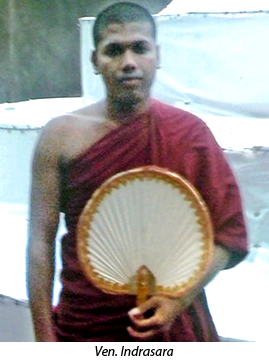
For centuries, the village temple has been the inspiration of life. The resident monk has been tasked with being a teacher, counsellor, mediator and enforcer of peace. Today, such temples are somewhat rare. With modernization and enhanced connectivity people in the city see their temples perhaps on a poya day: especially, the younger generation.
We were made aware of such a prudent monk and his faithful devotees in an isolated town located off Medawachchiya.
Thus, accompanied by my friend Nalin Chandra, we set off from the Colombo Fort Station in search of this temple.
 The night mail picked up momentum and soon the lights of the city gave way to darkness, where dense clusters of trees were visible. We got off at the Chendikulam Station around 2 am, and were met by a local contact and driven to our accommodation at Gajasinghapura.
The night mail picked up momentum and soon the lights of the city gave way to darkness, where dense clusters of trees were visible. We got off at the Chendikulam Station around 2 am, and were met by a local contact and driven to our accommodation at Gajasinghapura.
The chatter of birds and monkeys was part of the morning ritual in this faraway destination. We proceeded to the town of Maradhammaduwa, which does not even have a name board.
The road was in good condition but hardly any vehicles. On the way, I noticed a Hindu kovil dedicated to Hanuman and also a mosque.
A few shops were visible, and a few taxis were parked at the stand. Navigating a sand road we arrived at the small temple, and were greeted by Shantha Hamaduruwo (the junior monk).
Shortly afterwards, the chief priest Wijerathne Hamaduruwo walked in with a disarming smile. He soon engaged us in conversation. The prudent monk said, “I came here in 1995, and few farmers and their families were here.
We faced many hardships and threats. But I remained here”. Since then he has slowly built the confidence of these innocent villagers. Most of the village folk engaged in cultivation and many of them had once served in the Civil Defence Force as border guards, patrolling their areas with shotguns. Most of the villagers relied on the Kappachi wewa (lake) for cultivation, however, the water levels were low.
As it was a Sunday morning, there were many children attending the dahampasala (Sunday school). It was a delight to see these little girls and boys, some as small as four years clad in white.
They quickly gathered around us. Wijerathne hamaduruwo pointed at them and said, ‘These little ones don’t have access to drinking water. Clean water is a major crisis in this village. Often we have to buy water from a vendor who sells it to us at Rs four a litre.
Though we have a motor and pump at the temple the quality of the water in this land is not good enough”.
The tiny kids look up at me with earnest hope, assuming perhaps, that this visitor can bring them clean water. I spoke to these tiny Sri Lankans and was dismayed to realize that their school had classes from Grade 1 to 5.
They have to travel a long distance to attend another school to pursue classes from Grade 6 to the O/Ls.
Occasionally, they faced the threat of a lone elephant who roamed these areas. I was shocked to see the poverty of this village in this era of progressive development. Many older residents have kidney related ailments due to the water issue.
One such person is M.B.Kumarasinghe, 67, who needs Rs 5,000 every month for medical treatment. He clasps my hand in both his, and pleads that we help them to receive clean drinking water.
When we were getting ready to leave, the pious priest insists that we stay and have lunch with him. He came and sat down with us and we ate a typical village rice and curry.
Observing our interest in his village he invited us to visit the neighbouring village of Khongaskada. We reached this area after travelling for about 20 minutes. The muddy road to the temple was decorated with Buddhist flags.
The 180 families here were getting ready for a pinkama. The monk is 32 year old Ulukulame Indrasara. The small Sri Sobitharamaya temple does not have a chaithiya and the desire of these folk is to build one.
The monk says that the chaithiya when built will certainly be a radiant beacon of hope for these people who live a simple life, and he looks to the support of donors.
Soon, a long line of villagers clad in white appear carrying “ata pirikara”. There were Tamil and Muslim people participating in this event, a fine example of national unity. The faith of these villagers and the devotion shown is outstanding.
That night I pondered, how much the people in Colombo waste in their selfish indulgence while many of our brothers suffer in distant villages.
